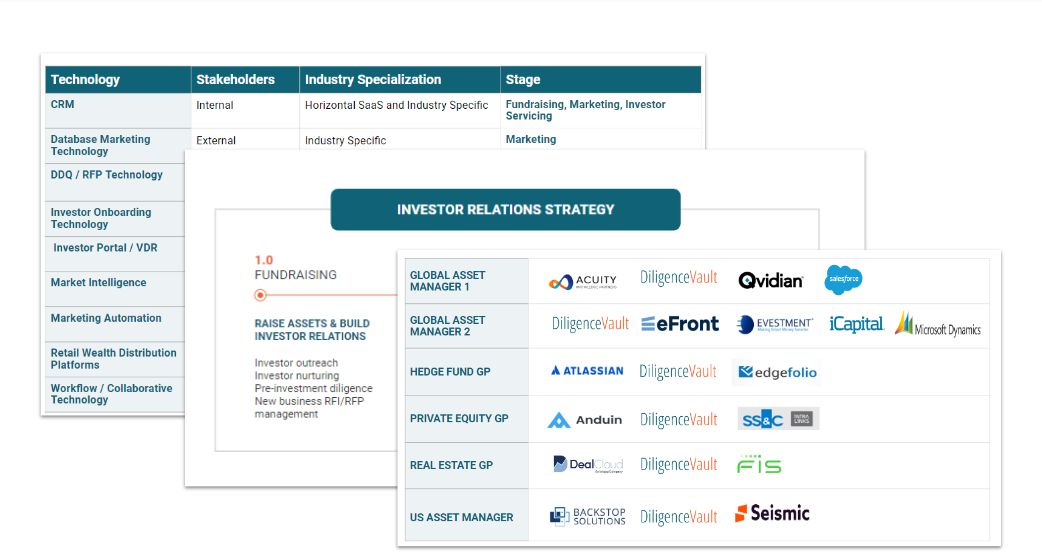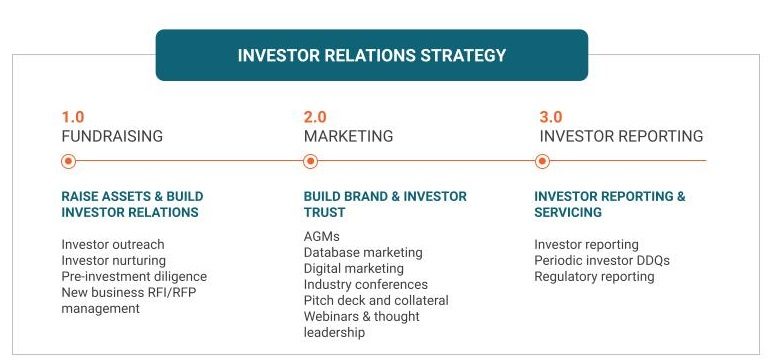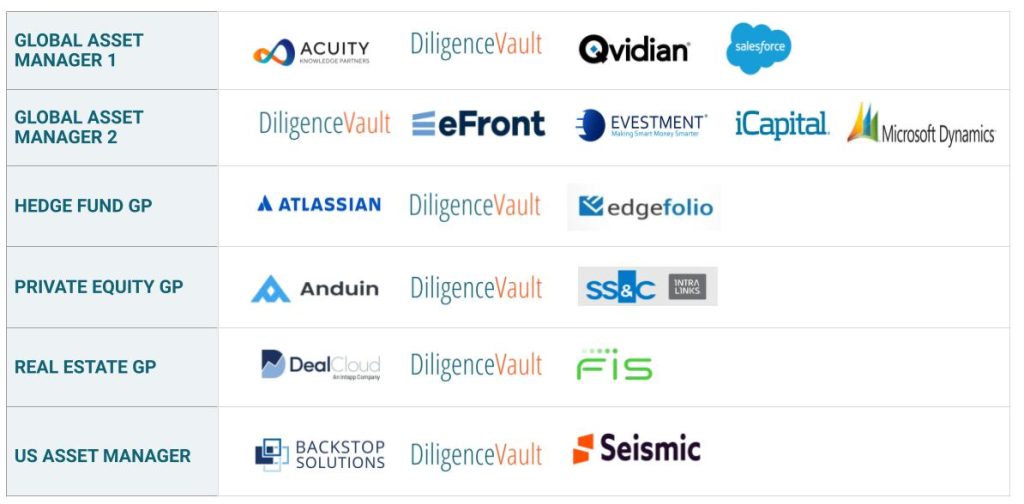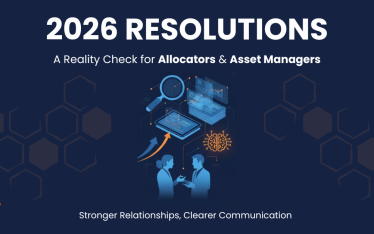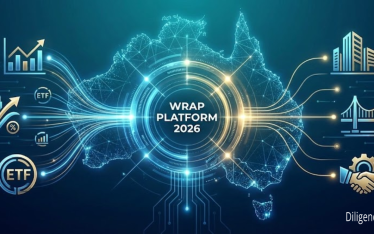Investor relations teams at asset managers/GPs are magicians. From fundraising and brand building strategies to post-investment reporting, these teams own a pivotal chapter in an asset managers success story. To do this job well, integrating technology and leveraging data becomes pivotal for investor relations functions. Before we get into the topic of what is an investor relations tech stack, let’s delve into what this function actually covers:
Sales, Fundraising, Capital Formation, Business Development: All Roads Lead to Rome
Successful capital raising or fundraising is a key component of revenue driver for asset managers. For a high-functioning IR team, data analytics and technology are key to streamlining sales processes, identifying potential investors, understanding their preferences, and tailoring pitches and diligence effectively.
- Investor outreach and nurturing: Access to the investor database with context around investment preferences is a starting point. Next comes research to understand the investors preferences, their asset allocations, the teams and their process to partner with asset manager. Investor relations teams then can harness technology in investor outreach ensures personalized pitch ensuring delivering relevant content to investors based on their behaviors and interests, while maintaining audit trail and reporting data. Data-driven insights aid in anticipating investor needs, fostering stronger and more enduring relationships.
- New business RFI/RFP: While pitching to investors and building relationships is key, equally important is applying to RFP/RFIs issued during a mandate search. Services like bfinance, DiligenceVault, and finsearches are technologies that help with identifying new RFI/RFPs. To improve success probability in this aspect, asset managers need to know of new searches, and also utilize technology to optimize the RFI/RFP response cycle. Additionally, leveraging AI-powered tools for content management and collaboration streamlines the process, enhancing both speed and quality of responses.
- Pre-investment diligence: Preparing standard diligence materials, facilitating information exchange with investors via data portals and email, and providing a concise message to the investors are key winning strategies in having effective pre-investment diligence. Being prepared and proactive approach are key differentiating factors in this stage. At DiligenceVault, we support several asset managers in this function and also improve the overall process by making industry DDQs available in a digital fashion.
A cohesive strategy leveraging technology ensures seamless alignment among sales efforts, investor relations, RFI/RFP processes, and pre-investment due diligence.
Asset Manager Marketing: Banking On the Brand Value
Integrating marketing functions and channels within asset management activities creates a high impact strategy ensuring a consistent brand narrative and robust investor engagement across all touchpoints.
- Annual General Meetings (AGMs): AGMs provide a prime opportunity for direct engagement with investor clients. AGMs can include keynote speeches, panel discussions, and Q&A sessions, fostering transparency and trust. The event itself becomes a marketing tool, reinforcing the asset manager’s brand and values.
- Database marketing: Another channel for asset managers is to ensure they have a robust database marketing strategy. Download the list of investment databases leveraged by investors to screen and search for asset managers.
- Digital and content marketing: In the digital realm, asset managers can employ various strategies—content marketing, social media, SEO, and targeted advertising—to enhance visibility of their brand and content and drive investor engagement. Content marketing, through insightful articles or reports, establishes thought leadership. Social media platforms facilitate ongoing engagement and communication, while SEO and targeted ads ensure visibility among potential investors actively seeking opportunities.
- Industry conferences: Conferences serve as networking hubs, providing opportunities to connect with prospects, share insights, and solidify relationships. While some conferences are designated for investor and asset manager cap intro, others are focused on investment strategies.
- Pitch deck and related collateral: Pitch decks serve as powerful tools to articulate value propositions and investment opportunities. Marketing elements here involve visual storytelling, aligning design with brand identity, and crafting compelling narratives. An engaging pitch deck not only informs but also resonates emotionally, leaving a lasting impression on investors.
- Webinars and thought leadership: Webinars offer a platform to share insights, discuss market trends, and showcase expertise. GPs can host webinars on investment strategies, market outlooks, or specialized topics, attracting potential investors seeking industry knowledge.
Marketing for asset management firms requires specialized skill sets that combine knowledge of modern marketing techniques, but also needs a deep understanding of the industry as well as the investment product. It’s a crucial element of the investor relations function that owns both building brands with new investors as well as deepening trust with the existing investor base.
Last, but not least, we focus on the third aspect of investor relations which focuses on efficient servicing of existing investor relationships.
Post-Investment Client Servicing: Ensuring Ongoing Trust and Transparency
Beyond the initial investment phase, the role of investor relations at asset managers extends into post-investment client servicing—an important aspect of maintaining trust and transparency with investors. Here’s how various elements contribute to this phase:
- Investor Reporting: Regular and comprehensive investor reporting is critical for fostering trust and keeping investors informed. Quarterly or periodic reports provide updates on fund performance, market insights, and portfolio positions. Subject to Most Favored Nations (MFN) or side letter agreements, customization of reports ensures adherence to specific investor preferences or agreements, showcasing the GP’s commitment to transparency and compliance.
- Periodic Completion of Investor DDQs: Investor Due Diligence Questionnaires (DDQs) are recurring assessments that investors use to evaluate asset managers performance, operations, and adherence to compliance standards. Asset managers can create a differentiated investor experience by ensuring accuracy and timeliness in completing these questionnaires. A well-organized repository of information, coupled with streamlined processes, enables prompt responses while maintaining consistency across responses to different investors. Our 2023 summer survey of over 800 asset managers provides insights into the state of RFPs and DDQs in the asset management industry.
- Regulatory reporting: For asset managers, reporting to regulators and adhering to their reporting requirements is imperative. This involves periodic submissions of reports to regulatory bodies, ensuring compliance with specific guidelines and regulations. Many investor servicing teams also work with their compliance and regulatory teams to support this aspect of reporting, as well as ensure related transparency for investors.
As we conclude highlighting various aspects of the investor relations function, we appreciate the need for a cohesive strategy across all three aspects – from marketing to fundraising to investor servicing. The data intensity and the process complexity necessitate a focus on leveraging a best-in-class investor relations tech stack to help operationalize entire investor relations value chain.
The Modern Investor Relations Tech Stack – 10+ Technologies
The investor relations technology stack for asset managers has modernized quite a bit over the last five years. Based on our research with our clients and users, we note that asset managers have chosen to use a combination of industry agnostic technologies along with purpose built vertical technologies to orchestrate their competitive advantage in support of their investor relations strategy.
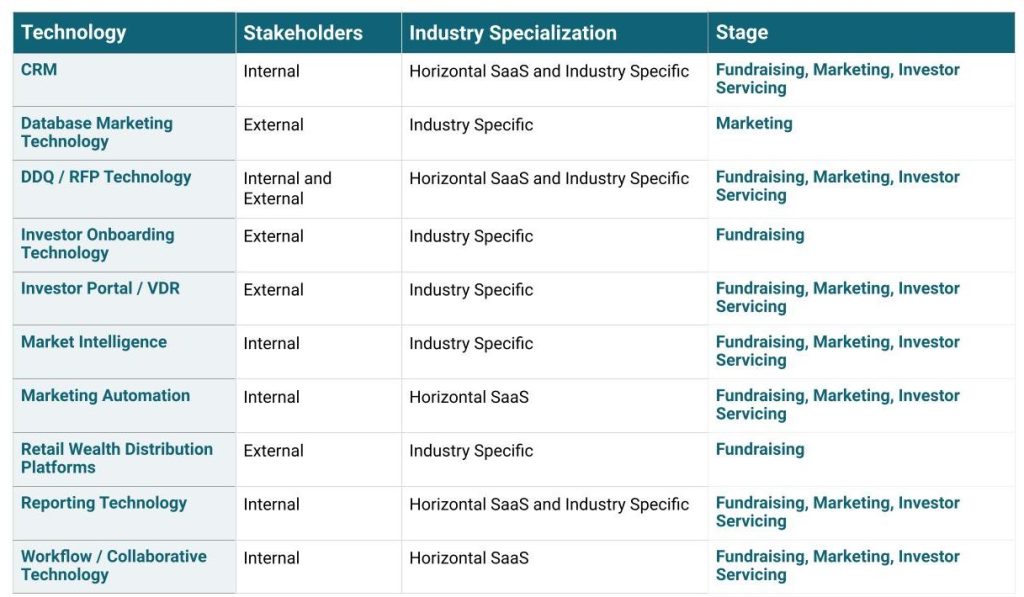
- Customer Relationship Management Systems (CRM): CRM systems streamline investor data management, enabling personalized interactions and targeted communication. They track investor preferences, allowing asset managers to tailor fundraising efforts to individual needs, thereby increasing efficiency in securing commitments. Horizontal CRMs are popular with large asset managers, however Dealcloud for private equity, Juniper Square for Real Estate, Affinity for Venture Capital and Backstop for Hedge Funds have gained acceptance.
- Virtual Data Rooms (VDRs): VDRs facilitate secure document sharing during fundraising. They expedite due diligence by providing investors with easy access to necessary information, fostering trust, and expediting decision-making processes. Intralinks has been the incumbent with the largest market share with over three dozen data portal offerings gaining traction.
- Investor portals: Creating branded portals for existing investors to access key documents, exposures and communications has also been gaining traction. However, the investor experience suffers as they are now tasked with maintaining access credentials for over 20 portals, and also introducing manually intensive friction for them to access individual portals.
- Marketing intelligence databases: Asset managers have begun to take advantage of marketing intelligence databases and technologies that provide insights into investors investing history and preferences, enabling tailored marketing campaigns.
- RFP/DDQ content systems: Automation streamlines RFP processes, improving response times and accuracy. These tools manage content libraries, ensuring consistency across responses, and freeing up time for GPs to focus on personalized aspects of proposals. – Horizontal and DV being the first industry specific technology.
- Database marketing technology and services: There are over 50 manager databases that are used by investors to source and assess fund managers. As a result, asset managers are tasked with maintaining firm, strategy and product information in these databases. There are specific technologies and services which assist asset managers in efficiently managing this function.
- Marketing automation technology: While many asset managers integrate this function with their CRMs, there are a few asset managers who have adopted Horizontal SaaS platforms including Horizontal SaaS such as Pardot, Mailchimp, Hubspot and others.
- Workflow and collaboration technology: Asset management is a regulated industry, which an extremely heavy information exchange needs. This complexity necessitates a need for an approval workflow that is scalable for high volume engagement. Further, investor engagement and diligence requires multiple stakeholders at the asset management firms to collaborate. As a result a workflow and collaboration technology investment is critical and many asset managers have opted for Horizontal solutions such as JIRA, Confluence, Trello and such to assist with these workflows.
- Retail/Wealth distribution platforms: Distribution of funds to wealth channels is a growth strategy for many asset managers, especially in the private markets space. This requires investments in new operational setup and access platform partnerships with firms such as iCapital, Moonfare, CAIS, Opto, Dot Investing and a few others.
- Investor onboarding technology: Investor subscription process is operationally complex given the KYC/AML requirements as well as the legal documentation needs. Onboarding platforms such as Anduin, Ontra, Passthrough, +Subscribe are industry specific solutions adopted by asset management firms.
- Client reporting technologies: Preparing those pitch decks, data intensive client ready reports, are all necessary but time-consuming elements. Technologies such as Kurtosys, Assette, Synthesis and a few other technologies come to mind.
To exemplify how these technologies come together, we include sample investor relations tech stacks at some of our asset manager clients:
A Technology that Reflects Asset Management Industry’s Investor Relations Priorities
Phew! We have enumerated 11 different technology groups that act as force multipliers, optimizing each segment of investor relations strategy. While the investor relations tech stack is necessary for asset managers to enhance accuracy, speed, and customization, leading to improved investor engagement and satisfaction, there is no fixed formula for success.
At DiligenceVault, we take pride in understanding our industry construct and processes, the purpose-built technology that is the DV platform and the multiple and often intertwined roles we play in powering all three segments (fundraising, marketing and client service) for our asset manager clients.
Here’s to win-win partnership with asset managers in building a scalable investor relations strategy efficiently and enabling them to focus on strategic aspects of investor relationships, fostering long-term partnerships beyond transactional interactions, as they continue to write success stories for their firms.
